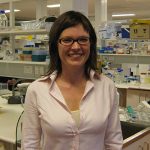Despite the resources invested in MS research, current therapeutics are not effective for all patients, often associated with severe side effects and do not promote repair or regeneration of damaged myelin. There are still many questions to be answered about the causes of illness, especially for different disease subtypes, and understanding what makes someone more likely to respond to therapy.
Currently, much research is ongoing into the potential uses of stem cells for treating or reversing aspect of MS disease. However these stem cells are typically mature stem cells derived from bone marrow or fatty tissue, that have limited capacity to specialise into other types of cells. Very new research has created a new type of stem cell, which allows normal adult cells to be reprogrammed into the earliest type of stem cell, known as induced pluripotent stem cells (iPSCs), which are similar to cells found in a developing embryo.
Dr Payne, working with Professor Claude Bernard and his team at Monash University, were the first group to derive iPSCs from people with MS. They have since shown that these cells have the ability to specialise (differentiate) into neural stem cells and the precursors of nerve cells. This development has triggered an enormous global research effort, as these cells provide a unique opportunity to study the very early stages of development.
Dr Payne’s project aims to perform extensive molecular profiling of these iPSC cells to understand more about the genes that are expressed at each stage of development, comparing between cells from people with MS and cells from healthy individuals. This will provide clues into whether MS risk can be identified much earlier in development, and help to differentiate between the roles of genes and the environment in causing MS symptoms.
Dr Payne’s project aimed to perform extensive molecular profiling of these iPSC cells to understand more about the genes that are expressed at each stage of development, comparing between cells from people with MS and cells from healthy individuals. This will provide clues into whether MS risk can be identified much earlier in development, and help to differentiate between the roles of genes and the environment in causing MS symptoms.
In this project, the researchers took skin cells from MS patients and their unaffected siblings, and converted them into iPSCs. These iPSCs were then grown and developed into neural stem cells (the precursors of mature brain cells) and mature nerve cells.
Dr Payne and colleagues then performed extensive molecular profiling to compare the original skin cells, iPSCs, neural stem cells, and nerve cells from people with MS and their healthy siblings. This was in order to identify any differences in the structure or function of these cells that might be relevant to the development of MS, or to their use in other applications such as cell therapy. These analyses found that structurally these cells are all very similar but the researchers found some important differences in genes that are expressed at higher levels in neural stem cells compared to iPSCs, that may be important for the development of MS. This molecular profiling has allowed the researchers to identify stem cells that may have potential to dampen inflammation and promote repair in MS.
Updated: 13 April 2016
$22,000
2015
1 year
Past project

